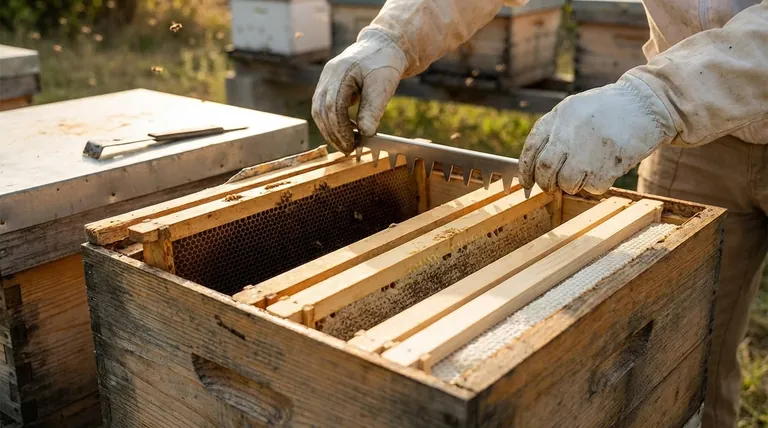Langstroth frame dimensions are standardized, with the most critical measurement being the top bar, which is always 19 inches long. The frame's depth, however, varies to fit one of three standard box sizes: Deep (9 1/8 inches), Medium (6 1/4 inches), or Shallow (5 3/8 inches).
The specific dimensions of a Langstroth frame are not arbitrary; they are precisely engineered to maintain the correct "bee space." This principle is the foundation of modern beekeeping, allowing for easy inspection and management of the hive.

Why Frame Dimensions Are a Standard
A Langstroth hive is a system of interchangeable parts. The standardized frame is the core component that makes this system work, ensuring frames from one manufacturer will fit into a box from another. This consistency is based on the behavioral biology of honey bees.
The Critical Top Bar: 19 Inches
The 19-inch top bar is the universal standard for all Langstroth frames, regardless of depth. Its ends are designed to rest on a recessed ledge, called a rabbet, inside the hive box. This ensures the frame is suspended perfectly, leaving the correct amount of space between the frame and the hive walls.
Frame Depth: Matching the Box to the Purpose
Frames come in three standard depths, each corresponding to a specific box size and beekeeping purpose.
- Deep Frames (9 1/8 inches): These are the largest frames and are used in deep hive bodies. They provide ample space for the queen to lay eggs and for the colony to raise brood.
- Medium Frames (6 1/4 inches): Used in medium boxes (often called "honey supers"), these are a popular, versatile choice. They are lighter than deeps when full of honey and are sometimes used for both brood and honey in a uniform-hive setup.
- Shallow Frames (5 3/8 inches): The lightest option, these are used in shallow supers. They are most often used for producing specialty comb honey, as the smaller frame is filled and capped more quickly.
Frame Width and Bee Space
The width of a standard Langstroth frame is typically 1 3/8 inches. When placed in a 10-frame hive body, this leaves a gap of roughly 3/8 of an inch between frames, known as bee space.
This gap is the genius of the Langstroth design. It is wide enough for bees to move freely but narrow enough that they will not build extra comb (burr comb) or seal it with propolis, which would glue the frames together.
Understanding the Trade-offs
Your choice of equipment directly impacts your beekeeping experience, primarily concerning hive weight and management style. The main decision is between an 8-frame and a 10-frame system.
The 10-Frame Standard
A 10-frame hive is the traditional standard. It offers more space for brood and honey in each box, potentially leading to a larger colony and higher honey yield per box. The primary drawback is weight; a deep 10-frame box full of honey can weigh over 80 pounds.
The 8-Frame Alternative
An 8-frame hive is narrower and holds two fewer frames per box. This makes each box significantly lighter and easier to lift, reducing physical strain. While an 8-frame hive holds less per box, you can simply add more boxes, causing the hive to grow vertically faster.
Making the Right Choice for Your Apiary
The frame and box dimensions you choose should align with your physical ability and beekeeping goals.
- If your primary focus is maximum colony size and you can handle heavy lifting: The 10-frame system with deep brood boxes is the traditional and most productive standard.
- If your primary focus is ease of handling and avoiding back strain: An 8-frame system using all medium-depth boxes for both brood and honey is an excellent and increasingly popular choice.
- If your primary focus is producing delicate comb honey: Using shallow frames and boxes on top of your hive is the ideal method.
Understanding these standard dimensions empowers you to build a modular hive system that works for both you and your bees.
Summary Table:
| Frame Type | Top Bar Length | Depth | Common Use |
|---|---|---|---|
| Deep | 19 inches | 9 1/8 inches | Brood rearing, large colonies |
| Medium | 19 inches | 6 1/4 inches | Versatile for brood & honey; lighter weight |
| Shallow | 19 inches | 5 3/8 inches | Specialty comb honey production |
Ready to equip your apiary with the right Langstroth frames?
As a trusted wholesale supplier to commercial apiaries and distributors, HONESTBEE provides high-quality, standard-dimension beekeeping supplies that ensure compatibility and efficiency. Our frames are built to last, helping you manage your hives effectively.
Contact our expert team today to discuss your wholesale needs and build a stronger, more productive beekeeping operation.
Visual Guide

Related Products
- Stainless Steel 9 Frame Hive Spacer Durable Precise for Commercial Beekeeping
- Long Langstroth Style Horizontal Top Bar Hive for Wholesale
- Plastic Bee Frame Beekeeping Hive Frames for Wholesale
- Heavy-Duty Stainless Steel Clip-On Frame Perch
- Assembled Wooden Bee Frames with Beeswax Foundation Ready to Use by HONESTBEE
People Also Ask
- Why is it important to maintain accurate measurements in a Langstroth hive? Ensure Hive Health and Manageability
- What is 'bee space' and why is it important? The Key to Modern Beekeeping Success
- What is the recommended number of frames for a beginner beekeeper? The Essential Rule for a Healthy Hive
- What to do if bees are building combs between frames? A Guide to Fixing Burr Comb
- How can 9 frames be used in a 10-frame box? Boost Honey Yield & Simplify Extraction



















